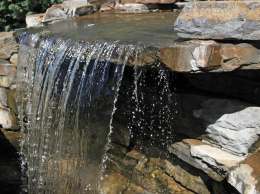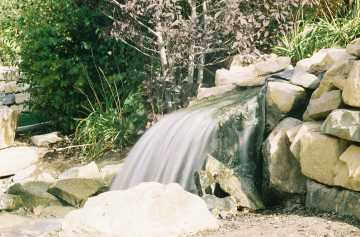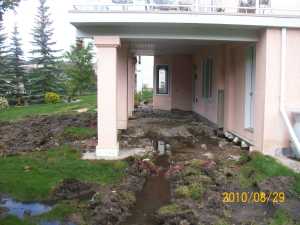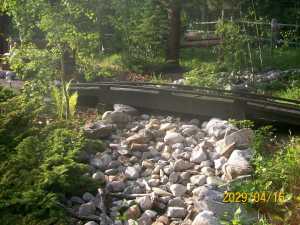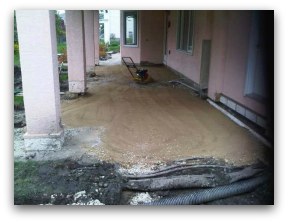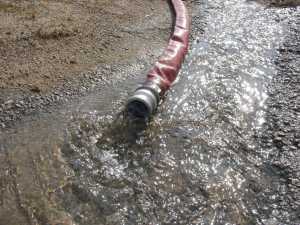| Back to Back Issues Page | ||||||
 |
||||||
|
Dreamtime, Issue #005 -- Landscaping Drainage July 20, 2012 |
||||||
Water! Rain! Run-off! and more!
Table of Contents1. Thoughts & Inspiration 2. Feature Article: Landscaping Drainage 3. What's New at Dream-yard 4. Share 1. Thoughts & InspirationThis month's newsletter is dedicated to water. “The work an unknown good man has done, is like a vein of water flowing hidden underground, secretly making the ground green.” “Nothing is softer or more flexible than water, yet nothing can resist it.”
Water is the driving force of all nature. 2. Feature Article: Landscaping Drainage
Almost everyone at one time or another will have to deal with landscaping drainage in their yard. It may be from excessive rains, or in the planning stages of a project requiring drainage. So we decided to focus this month's feature article on Landscaping drainage. From my experience as a landscaper, landscape drainage is either overlooked, or overcomplicated.
By this I mean that some homeowners forget to deal with it, while others make it more difficult than it has to be. This article will introduce you to different methods of yard drainage. We want you to be able to control your water problems the easiest, most practical, and legal way you can. I was pretty fortunate back in my high school geology days to be exposed to mother nature's destructive forces. I wrote a pretty extensive paper on stream erosional processes, and from that point on, I never underestimated the powerful forces of water. Let us not forget the physics of frozen water either. Depending on different factors, water expansion can exert a force of tens of thousands of psi (pounds per square inch). Frost can easily wreak havoc on walls, patios, and other features in your yard, while surface water erosion can create problems in lawns, gardens, soil, and gravel quite easily. No matter what drainage method you use, you should always consider erosion control. This could simply mean a few rocks placed under a downspout, or flowing water into a decorative rock bed. Use any means you can to break up the heaviest portions of flow, to lesson the impact of erosion. Standing water can also affect the health of your lawn and gardens in negative ways. It can be a breeding ground for mosquitoes, and lead to unwanted growth of mushrooms, or mosses. Lawn drainage is very important, and we will talk about ways to deal with it later on. Surface water comes from rain, melting snow and ice. Groundwater comes from the water table itself. A high water table can negatively affect landscape drainage, or even a landscaping project (during and after construction). Compacted soil from foot traffic, heavy clay soil, and a high water table are all directly linked to the permeability of your soil. If water is already there, or there is a barrier from preventing absorption, you can have problems. How do we deal with the problem?There are 3 main ways to deal with drainage problems. The first two ways are for more serious problems that require you to move heavier amounts of water. The last one is for smaller amounts of water, less serious problems, and more eco-friendly methods. Keep in mind that more and more cities and towns are promoting the eco-friendly ways of allowing water to permeate through your soil into the water table. This is mother nature's way of filtering impurities and pollution out of stormwater and lessoning the impact of erosion. Let's start with the first two. The least complicated, and preferred way for many landscapers is to use the surface first. Here are a few types of surface modifications that you can consider. There is very little, or no maintenance required for these methods.
The second way of dealing with water is to move it off, or to another area by using underground piping, or plumbing of some sort.
The last way is for smaller drainage problems, less severe amounts of water, and more eco-friendly methods. The first two have limitations to how much water they can accommodate. However, advanced dry well systems, and rain gardens can handle substantial amounts if done properly.
There are also variations, or different combinations of the above methods. With all the choices we have, how do we deal with it effectively, practically and legally? EffectivelyYou must choose the one or ones that will work the best for you and your situation. Here are a few examples to consider for effective methods: Plumbing downspouts to a series of drain pipes may be an option, but the plumbing must be sufficient enough to handle water at peak amounts. If not, they may back up and create other problems for you. If you live on a fairly flat small piece of property, french drains and plumbing may not be an effective solution. You will require sufficient grades to move the water. Always keep in mind with plumbing and grading, that a minimum grade of 2% should be your goal. Don't limit yourself either. If it is a large piece of property with a substantial amount of water, you could build more than one dry well. PracticallyTry to make it work with the rest of your yard. This means you will have to consider how will it affect your current features? Here are a few examples to consider for practical thinking: Plumbing, drain tiles, and french drains will require excavating into the ground. If you have any buried utilities, cables, irrigation lines and lighting wires that may be affected, it may limit your choices of where, how, and what you can do. This may also make the costs exceed your budget, or abilities. Swales, berms, and regrading may not be a practical option with a well developed yard of pre-existing features. Your goal should be to cause as little disturbance to your yard as you can to improve your drainage. LegallyIt is important that you follow any local building codes you may have in your city or town during construction. You will also have to investigate local laws on what your responsibility is with the end result of your flow. Where is the water going? And what effect will it have on your neighbour's, or the city's property? Does your city allow you to channel into their storm systems? You don't want to end up in any legal battles. Sometimes the house beside you may be having the same problems, so always try to work with people, rather than against them. Hopefully, you aren't dealing with a neighbour that is directing an excess amount of water onto your property. These situations can be difficult to work out. Check with your local authorities on what each person's responsibility is, then try and find a peaceful resolve if you can. It is always better to work things out together, before taking legal actions. Let's take a closer look at what each drainage method is, so you have a better understanding of your choices.Berms and Swales These are fairly simple ways to control water, but they do require making changes to your yard. Essentially, a Berm is mounded dirt that acts more like a barrier in preventing water from moving over it. A Swale is the opposite of a berm being a slight depression, or ditch. They are used to collect water from higher points, and channel it away to another location like a road, or back alley. When contractors and landscapers build new subdivisions, they use berms and swales when grading properties. Usually, swales are placed between the properties with the lowest point becoming the property line, This is to collect water from each property and channel it to the road. Of course this can be more challenging when the street is on a hill. Dry river beds are also fairly easy projects to deal with drainage problems. A dry river bed is the most appealing way to fix the problem. They can compliment and complete water features, gardens, and bridges.
If you are looking for more in depth information on building a dry river bed, please visit our how-to module. There are tons of time and money saving tips in this start to finish how-to. Grading we touched on this while talking about berms and swales. Grading requires you to be able to build up, or remove soil as required to direct it away from your home and off, or to another area of your property. Generally, landscape companies should grade away from a house properly, so you don't have to deal with it later. Of course this is not a perfect world. Sometimes poor work, or even the settling of land can lead to drainage problems. I have had calls to look at grading problems where water was sloping into the house on more than one occasion. (This can be challenging). Sometimes a sump pump is the only answer. Houses that are set below the land around them, often have these sump pump systems. Grading is simple if there is currently no landscaping done. The ground should be higher at the house, and slope away to the street, or back alley, usually at a grade of about 2%.
They are essentially gravel filled trenches with weeping tile, or perforated pipe wrapped in landscaping cloth. The landscaping fabric is used to prevent soil, and other foreign materials from clogging up the pipe. They are one of the most popular drainage methods used in landscaping. The idea is that most of the water collected from the source, will weep out the drain holes into the gravel and surrounding soil. The overflow will continue to the end of the tile. You may end it at a sewer, dry well or any other location that works for you. This method of drainage is also used to remove water behind retaining walls. This helps to prevent frost heave from pushing and shifting your wall. Pop up Valves are simple outlets at the end of your downspout plumbing. They work off the pressure of water in the downspout to open up and release the water in a more convenient place. This could be close to a curb, swale, dry river bed, or decorative rock bed. A great spot to have a pop up valve could be a rain garden with well draining sandy soil. The concept of rain gardens is old, but new. Old in the sense that we have been aware of it and used it for thousands of years. New because more towns and cities are adopting the term and method as more of a standard way to deal with storm drainage. There is a great video link that covers pop-up valves, and dry wells. You can find it at the end of this article when we talk about dry wells. Straight plumbing to drains, and storm sewers I really don't feel they need any explanation, except to differentiate between drain tile, weeping tile, perforated drain pipe, and regular pipe. Drain tiles we talked about above, and is more of a collective word. It is used to describe piping systems that have holes to allow water to seep (weep), out into the surrounding soil. Perforated drain pipe, and weeping tile are the two most popular names you will here for this function. Pipes are solid, or closed ways to move water to another desired area like a sewer, or storm drain. We mentioned a legal responsibility may exist here with water leaving your property to enter the street, or sewer system. With this method you must be aware of local building codes and by-laws. These are different in every city, so you must investigate these yourself.
Sump pumps are usually found in basements, and are used in the landscape when there is no other way to move water with gravity. They are placed at the lowest possible collection spot which is referred to as the “Sump”. The water is then pumped from here here to another location. They can fail, and they do require maintenance, but they still can come in very handy. Environmentally Responsible Methods These last methods of drainage are more environmentally responsible ways to deal with drainage issues. They limit the water entering storm drains and eventually into our waterways. The water is filtered through the soil, which is mother nature's purification process of water. Cities have conducted studies that show this cuts down on pollution by over 25%. Here is a great web article on the hydro-logic cycle. This will better help you understand the importance of these next few methods. It also talks about rain gardens and how they work. Aeration and soil improvements are important for the health of your lawn and garden as they help with absorption of water. Having a permeable soil will prevent water “runoff” when watering and will cut down on waste. Aeration is something that should be done at least once a year. Please visit our module aeration module for a better understanding of all the benefits. Ponds and other water features are not really the most practical way to deal with excess water. These are often controlled environments, and you have no control over mother nature. I have had a few people over the years want to build waterfalls under downspouts, or ponds to collect excess rain water. They really just end up being a dry river bed with a cascade when it rains. Think about it this way. How many people will venture out in the rain to admire your efforts? It just doesn't make a lot of sense. This doesn't mean that you can't make it work for you, but just be aware that it sounds better in your head, or on paper than it usually is. Ponds may also seem like a simple solution, but they don't take care of themselves. You also have to think about where the overflow water will go? Are you willing to look after the pond? It may end up being a little more maintenance than you planned on. Again, you may be able to make this work for you, but think it through very carefully first. Rain gardens, and water loving plants are becoming more and more popular with homeowners, and government agencies. We mentioned these when we talked about pop-up valves earlier. At Dream Yard we sometimes like to have fun and coin our own terms, so let's call this rain garden a “Yard sponge”. A yard sponge is a low, water loving planted garden area in your yard designed to collect excess water and allow it to be absorbed into the soil. It must be the right soil, and subsoil to be 100% effective. This means that 5 inches of garden soil over a clay base of subsoil will not work as well as you might expect. Remember that clay is made up of tiny particles packed very tightly together, and does not allow water to permeate through it very well. How do you know if you have clay? When you squeeze clay in your hand to make a ball, it will stick together instead of breaking apart, or crumbling when you roll it around. Chances are high that you may have to excavate a large amount of soil and replace it. You will need a soil mix with at least 50% sand for an effective rain garden. How deep you go may depend on how large your yard is, how much water, and what is planted in the garden. Here is a link to a look at how one city is using these environmentally friendly methods in a positive and proven way. Dry wells are a similar concept to a rain garden without the plants. They are underground cavities used to disperse water into the surrounding soil. The cavity can be filled with rocks, or it can be a special reservoir made of plastic, or concrete with holes. The holes will allow seepage into the surrounding soil. Dry wells filled with rocks have a limited amount of storage capabilities. Once the surrounding soil is saturated, they can no longer take in water faster than it seeps out. Buried reservoirs have much more space to store larger amounts of water. Here is a great video from a manufacturer on drainage. It covers dry wells and pop-up valves, and is well worth watching.
So hopefully you have gained a little more insight into the different types of drainage so you can decide on a plan that works best for you. Remember to choose a method that is effective, legal, and practical. You may have to combine a few different methods to make your drainage work, and that's ok. We hope you enjoy our site and visit us again. We also hope you have success with all your DIY landscaping projects. If you have any questions or comments on our site please feel free to Contact Us at any time. Thanks for visiting and have a wonderful day. The Dream-yard Team. 3. What's new at Dream-yardWe love the site Pinterest! There are fantastic ideas out there on the web and we are happy to be able to share some of our favourites with you in our landscaping and gardening boards. Don't miss it! Sign up for our RSS feed so you never miss a new addition to the site. Finally complete, some new how-to modules!"New" How-to Module: How-to Build a Dry-laid Flagstone Walkway DIY "Your Landscaping Stories": A new section where you can share your stories about projects you have undertaken. You'll be able to do a great write-up and post pictures for bragging rights on all your hard work. It will be your very own web page that you can share with friends and family. 4. ShareIf you are not familiar with our site, we have a picture ideas section that is growing every week. We are looking for submissions from both professionals and homeowners that wish to showcase their work. For those of you with websites, we provide a link to your site to credit you with the work. For those of you interested in displaying your pictures, please feel free to Contact Us. See something you like on our site, give us a "like on facebook" and share with your friends. Our goal is to be the most informative, and educational landscaping site on the internet. This will give homeowners the resources they need to build their very own dream yard. See you in a few weeks with our next edition! The Dream-yard Team |
||||||
| Back to Back Issues Page |
